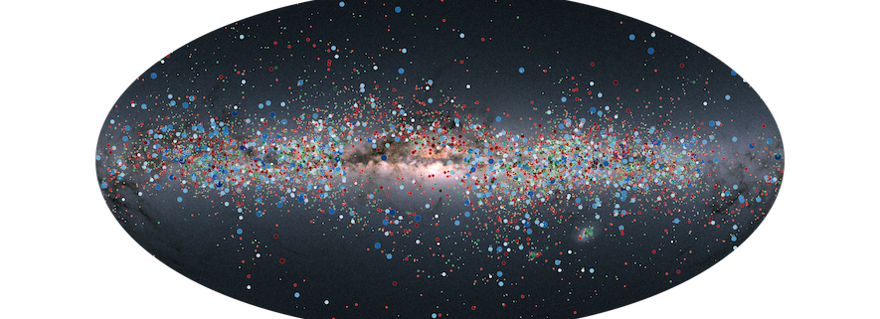
The European Space Agency (ESA) has published an interim data release from Gaia, the space telescope mapping out the Milky Way in 3D. The first scientific papers published today reveal half a million stars in the Omega Centauri globular cluster, nearly 400 candidate gravitational lensers and the positions of more than 150,000 asteroids in the solar system. 'This data release is another stunning demonstration of Gaia's enormous impact,' says Leiden astronomer Anthony Brown.

Space telescope Gaia is mapping the Milky Way in great detail, completing the most accurate star count ever. Distances, positions, self-motion and other properties of billions of stars are mapped. The latest data release builds on this but also offers unexpected science: findings that go far beyond what Gaia was originally designed for. The data is now available to astronomers worldwide for further analysis.
Globular cluster
The previous data release (DR3) contained data on more than 1.8 billion stars, building a fairly complete picture of the Milky Way and beyond. Gaia had not yet explored areas of the sky made up of very densely packed stars. Globular clusters, the oldest objects in the universe, are an important example. To fill one of the gaps in the map, Omega Centauri was selected, the largest globular cluster visible from Earth. Instead of focusing on individual stars only, Gaia switched on a special mode to map a larger patch of sky around the cluster's core every time the cluster came into view. The telescope discovered more than half a million new stars in Omega Centauri that had not been seen by Gaia before
Gravity lenses
Gravitational lensing occurs when the image of a distant object is distorted by an anterior mass - e.g. a star or galaxy - located between the observer and the object. The mass acts as a giant magnifying glass, or lens, that can amplify the brightness of light and give multiple images of the distant source. These remarkable and rare configurations are visually intriguing and have great scientific value. They reveal unique clues about the early days of the universe. Some objects are not ordinary stars but distant quasars - extremely bright, high-energy galaxies powered by black holes. Gaia has found 381 candidates for lensed quasars, a goldmine for cosmologists and the largest set of candidates ever detected in one go.

Asteroids
Of 156,823 asteroids, small rocky celestial bodies located in a belt between the planets Mars and Jupiter, Gaia has measured the positions over a period almost twice as long as the previous one, making most orbits now 20 times more accurate. Gaia's next data release (DR4, around the end of 2025) will add comets and moons to this set and also include twice as many asteroids.
Milky Way
The data released today also includes new information about the Milky Way's disk. By combining six million spectra, Gaia has for the first time been able to produce extremely faint imprints of the gas and dust located between the stars. The Gaia team hopes the dataset will allow scientists to finally determine the source of these signals, which are suspected to be complex organic molecules. Finally, the dynamics have been characterised of 10,000 pulsating giant stars and giants in binary stars in by far the largest database in the field.
'This data release is another wonderful demonstration of Gaia's enormous impact on all branches of astronomy, from the incredibly accurate mapping of asteroids in our solar system to the detection of new lensed quasars in the farthest ends of the universe. 'I look forward to the creative scientific applications of this data release,' says head of the Gaia Data Processing and Analysis Consortium Anthony Brown (Leiden University).
Next steps
Gaia's previous data release, Gaia DR3, took place on 13 June 2022. It was the most detailed survey of the Milky Way to date and provided a wealth of data on strange 'star quakes', asymmetrically moving stars, stellar DNA and much more. Gaia DR3 included new and enhanced details for nearly two billion stars in the Milky Way and the largest catalogues of binary stars, thousands of objects in the solar system and - further away and outside our galaxy - millions of galaxies and quasars. The mission's next dataset, Gaia DR4, is not expected before the end of 2025. It will build on both Gaia DR3 and the interim focused data release released today.
Scientific publications
Read all papers included in the Gaia focused product release ESA's website.
This article appeared as a press release on the website of the Nederlandse Onderzoekschool voor Astronomie (NOVA).
Images: ESA/Gaia/DPAC






